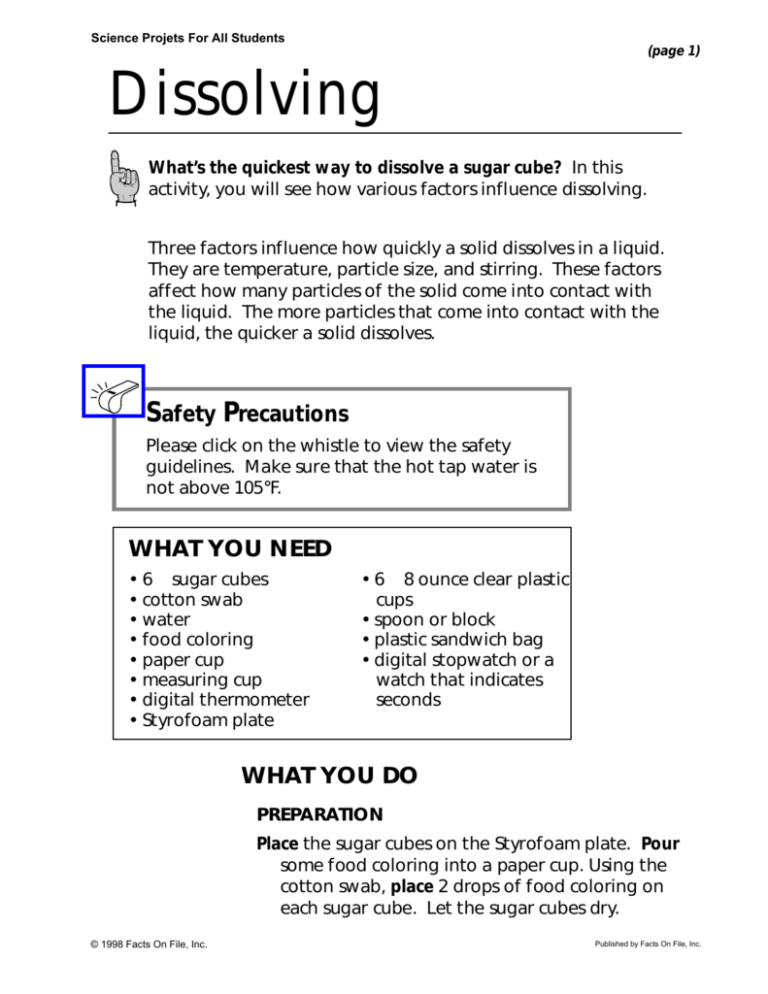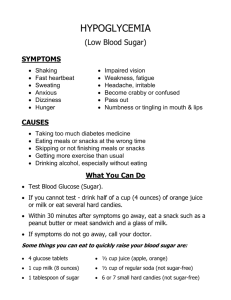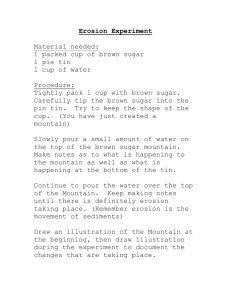Dissolving - Facts on File
advertisement

4.7 (page 1) Science Projects Projets For Students Science ForAll ALL Students Dissolving What’s the quickest way to dissolve a sugar cube? In this activity, you will see how various factors influence dissolving. Three factors influence how quickly a solid dissolves in a liquid. They are temperature, particle size, and stirring. These factors affect how many particles of the solid come into contact with the liquid. The more particles that come into contact with the liquid, the quicker a solid dissolves. Safety Precautions Please click on the whistle to view the safety guidelines. Make sure that the hot tap water is not above 105°F. WHAT YOU NEED WHAT YOU NEED • 6 sugar cubes • cotton swab • water • food coloring • paper cup • measuring cup • digital thermometer • Styrofoam plate • 6 8 ounce clear plastic cups • spoon or block • plastic sandwich bag • digital stopwatch or a watch that indicates seconds WHAT YOU DO PREPARATION Place the sugar cubes on the Styrofoam plate. Pour some food coloring into a paper cup. Using the cotton swab, place 2 drops of food coloring on each sugar cube. Let the sugar cubes dry. © 1998 Facts On File, Inc. Published by Facts On File, Inc. 4.7 (page 2) Science AllALL Students Science Projets ProjectsFor For Students TEMPERATURE 1. Label 1 cup “HOT. “ Label the other cup “COLD.” 2. Place fi cup of hot tap water in the cup marked “Hot.” Add a sugar cube. 3. Use the stopwatch to time how long it takes for the cube to dissolve completely. Record the time in the data table under “Hot.” 4. Place fi cup of cold tap water in the cup marked “Cold.” Add a sugar cube. 5. Use the stopwatch to time how long it takes for the cube to dissolve completely. Record the time in the data table under “Cold.” PARTICLE SIZE 1. Label 1 cup “WHOLE. “ Label the other cup “CRUSHED.” 2. Place fi cup of water in each plastic cup. Use the thermometer to make sure the water is the same temperature. 3. Put the whole sugar cube into the cup marked “Whole.” 4. Use the stopwatch to time how long it takes for the cube to dissolve completely. Record the time in the data table “Whole.” 5. Put 1 sugar cube into the plastic bag and use the block or the back of the spoon to crush it. © 1998 Facts On File, Inc. Published by Facts On File, Inc. 4.7 (page 3) Science Projects Projets For Students Science ForAll ALL Students 6. Pour the crushed sugar into the cup marked “Crushed.” 7. Use the stopwatch to time how long it takes for the sugar to dissolve completely. Record the time in the data table under "Crushed." STIRRING 1. Label one cup “STIRRED. “ Label the other cup “NOT STIRRED.” 2. Place fi cup of water in each plastic cup. Use the thermometer to make sure the water is the same temperature. 3. Put a whole sugar cube into each cup. 4. Use the teaspoon to stir the cube in the cup marked “Stirred.” Time how long it takes for the cube to dissolve completely. Record the time in the data table under “Stirring.” 5. Time how long it takes for the cube in the “Not Stirred” cup to dissolve. Record the time in the data table under “Not Stirred.” © 1998 Facts On File, Inc. Published by Facts On File, Inc. 4.7 (page 4) Science For AllALL Students ScienceProjets Projects For Students OBSERVATION 1. How does temperature affect dissolving? Why? 2. How does particle size affect dissolving? Why? 3. How does stirring effect dissolving? Why? 4. What is the quickest way to dissolve a sugar cube? OUR FINDINGS Click on the above link to see what we found. © 1998 Facts On File, Inc. Published by Facts On File, Inc. 4.7 (page 5) Science Projects Projets For Students Science ForAll ALL Students DISSOLVING DATA TABLE Factor Time to dissolve Temperature Hot Cold Particle Size Hot Cold Stirring Hot Cold © 1998 Facts On File, Inc. Published by Facts On File, Inc. Our Findings 4. PHYSICAL SCIENCES 4.7 DISSOLVING 1. Dissolving speeds up when the temperature increases. Heating causes the molecules of the liquid and the solid to move farther apart. They also move more rapidly. Therefore, the particles of the 2 substances come into contact more easily. 2. Smaller particles dissolve more rapidly. The crushed sugar cube dissolved more rapidly because more of the sugar particles were exposed to the water. 3. Stirring speeds up dissolving. It brings more of the sugar particles into contact with the water particles. 4. The quickest way to dissolve a sugar cube is to stir a crushed cube in hot water. Science Projects Projets For Students Science ForAll ALL Students SAFETY GUIDELINES Special Safety Note To Experimenters Some activities in this book have special safety rules to follow. The special rules are on the page with that activity. But even if every safety rule in the world is included with an experiment, you have to know how to be safe when doing it. So it’s very important that you read, copy, and follow the Everyday Safety Rules that follow. Sometimes science experiments can be dangerous. Things can spill, break, or even catch fire. You have to know what to do. . . fast. So be prepared. Read the directions for each experiment carefully, and follow any special safety rules listed with it, then be careful. Always follow common-sense safety rules like NEVER RUN WITH SCISSORS IN YOUR HAND or BE CAREFUL WITH HOT THINGS! You already know a lot of common-sense safety rules. . . so remember to follow them, and have fun! Everyday Safety Rules PREPARE • Clear off your work space. • Read all directions. • Know what problems might happen, and be prepared. PROTECT YOURSELF • Follow directions step-by-step. • Do just one experiment at a time. • Locate exits, fire extinguisher, eye wash, and first-aid kit before you start. Ask an adult to show you how to use a fire extinguisher. • Be sure there’s fresh air in the room. • Wear an apron and safety goggles. • Don’t wear contact lenses, have bare feet, or wear very loose clothing. • Keep work space and floor clean. • Clean up spills immediately, © 1998 Facts On File, Inc. Published by Facts On File, Inc. Science ForFor All ALL Students ScienceProjets Projects Students • Don’t drink or eat around the experiment work space. • Don’t eat or drink any stuff tested, unless a grown-up says it’s OK. USE EQUIPMENT CAREFULLY • Don’t set up equipment too near the edge of your work space. • Be cautious when using pointed or sharp instruments, like scissors, screwdrivers, or knives. • Unplug any electric device by pulling out the plug, not pulling on the cord. • Use only low-voltage batteries, like those used in flashlights or smaller. • Be careful when using chairs or step-stools. USING CHEMICALS • Have an adult help you with all experiments requiring chemicals. • Don’t inhale or taste chemicals. • Read all labels carefully. • Label all chemicals. • Wear goggles, apron, and gloves so chemicals don’t touch your skin. • Wash hands before and after using solutions. • Wipe up spills thoroughly. HEATING THINGS • Wear goggles, apron, and gloves when boiling water. • Use safety tongs and heat-resistant mitten or hot pads. • Never leave heated things unattended. • Turn off hot plates and oven burners when you’re finished. • Keep flammable things away from heat and flames. • Have a fire extinguisher ready. IN THE FIELD • Never go on a field trip alone: follow the Buddy System. • Tell a responsible grown-up where you’re going. • Know the area and be aware of dangers, like poisonous plants and deep water • Dress for the weather conditions. © 1998 Facts On File, Inc. Published by Facts On File, Inc.






